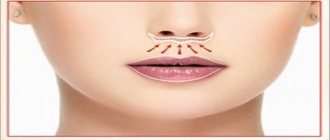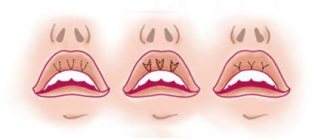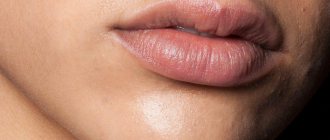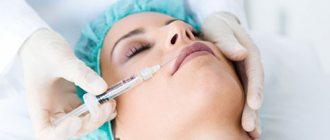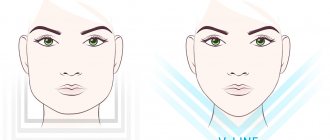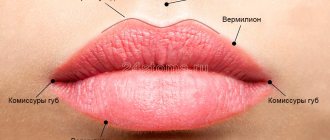Bull horns - this is how the name of the bullhorn plastic surgery is translated from English. The etymology of the name is related to the shape of the skin incision used for surgical access. The incision runs under the base of the nose and looks very much like the horns of a bull. Hence the name of the operation - bull horn.
Bullhorn cheiloplasty is indicated for women who, for some reason, have an increased distance from the edge of the upper lip to the base of the nose. The source of a cosmetic defect may be gravitational shift of tissues against the background of age-related changes. Some girls have this defect from birth. Injuries and previous surgeries are other possible causes of cosmetic defects.
When talking about a cosmetic defect, we need to add the epithet “relative”. It is impossible to talk about indications for surgery without touching on the topic of harmonious facial proportions, and we will dwell on this issue in more detail. Often, a low upper lip is not a defect and does not require correction. However, if an increase in the distance between the nose and lip is subjectively perceived by a woman as a disadvantage, it makes sense to think about a simple operation and sign up for a free consultation with a plastic surgeon.
What is a bullhorn?
Bulhorn is a plastic surgery to lift the upper lip (a type of cheiloplasty), aimed at reducing the skin flap above the upper lip, which allows you to slightly lift the lip and make it more voluminous.
Bullhorn surgery helps correct a congenital facial feature - a disproportionately large distance between the base of the nose and the edge of the red border of the upper lip.
This is achieved by reducing the skin between the lips and nose. During the operation, a piece of skin is excised just under the base of the nose.
The seam accurately follows the contours of the natural border of the base of the nose and resembles the shape of a bull's horn. Hence the name - bullhorn, which translated from English means “bull horn”.
Due to this shape, the seam becomes practically invisible in the future; no one will think that an operation was performed.
The upper lip lift using the bullhorn method helps to harmonize the proportions of the face and make the upper lip naturally fuller, but without protruding. The smile becomes more open, the facial expression becomes more welcoming and harmonious.
License
In the last decade, there has been a boom in the proposed cosmetics and methods for increasing lip volume and treating age-related changes in the lower third of the face.
Surgical lifting remains the gold standard for eliminating facial soft tissue ptosis.
However, the best results in facial rejuvenation (and the perioral area in particular) are achieved by combining skin care products and modern minimally invasive procedures using laser and radio wave technologies, dermabrasion and chemical peels, fillers and botulinum toxin.
Almost twenty years of observation of patients have shown that the timely use of such an integrated approach in combination with successful dental prosthetics can actually slow down the processes of involutional changes in the lower third of the face by 10-15 years, which is very important for socially active women.
The concept of beautiful lips is based on the external perception of the shape and proportions of young lips. Today we evaluate the aesthetics of the lips based on seven main parameters: the height of the upper lip, the shape of its central and lateral parts, the outline of the lower lip, volume, classic or approximately equal proportions of the lips, and the position of the commissures. The beauty of a smile is also an integral part of lip aesthetics.
Numerous studies have shown that the depth of wrinkles changes with age. It has been confirmed that wrinkles in the upper third of the face are associated with facial expressions, and their premature appearance has been noted not only in emotional people, but also in people suffering, for example, from headaches.
Studies have shown that the appearance of wrinkles in the skin of the upper lip is associated with the decline of reproductive function and a decrease in estrogen levels. The appearance of wrinkles in women precisely during perimenopause (45-55 years) with progression in postmenopause (after 50-55 years) is a reflection of estrogen-deficient aging. This theory is confirmed by the fact that men have no upper lip wrinkles. However, their premature formation may indicate both early menopause and, for example, smoking abuse, as well as impaired occlusion, hypertonicity of the masticatory and orbicularis oris muscles, and psycho-neurological disorders.
11 signs of aging face and neck:
- Forehead wrinkles;
- Depth of crow's feet;
- Number of crow's feet;
- Wrinkles between the eyebrows;
- Bags under the eyes;
- Wrinkles under the eyes;
- Nasolabial fold;
- Wrinkles at the corners of the mouth;
- Wrinkles of the upper lip;
- Ptosis of the lower face;
- Circular folds of the neck.
The main signs of aging of the lower third of the face:
- Nasolabial fold;
- Wrinkles at the corners of the mouth;
- Wrinkles of the upper lip;
- Wrinkles of the lower lip.
Everything that human nature contains is put into his mouth. They express reason and madness, strength and weakness, delicacy and rudeness. They represent the seat of love and hate, sincerity and hypocrisy, humility and pride, truth and lies.
Johann Caspar Lavater
LIPS IN THE GENERAL PICTURE OF THE FACE
At all times, full, beautiful lips with a clear contour were considered the ideal. This preference has deep sociocultural roots and is associated with reproductive needs: plump lips are associated with youth and attractiveness.
Children's swollen lips in the shape of a “bow” evoke our tenderness as a child; sensual lips - in the form of a “rosebud”, with a pronounced “Cupid’s arch” - attract attention and give special attractiveness to a woman’s face, and pale, tightly closed, thin lips with mournfully drooping corners are associated with old age. The lips of the speaker and singer attract attention: we are fascinated by the dance of the lips to the music of the voice. The famous physiognomist Yamblik wrote that the ancient philosophers, before accepting a student, subjected his mouth to a thorough examination. Lips, teeth, smile (softness, kindness, affection, dreaminess and passivity) relax the lips. Excessive timidity, weak character, laziness, pliability to someone else's influence - they open their mouths slightly.
Lips can tell many secrets about who they belong to. French doctor Michel Renault found an original use for lip impressions in forensic science. He found that the surface relief of the lips, like the fingertips, is absolutely individual. After examining several thousand people, Reno did not find identical prints with the exception of a pair of twins. At the beginning of the last century, an accurate test was developed based on this observation: to obtain an imprint, the subject had to apply lipstick and press his lips to a white sheet of paper. Lips are undoubtedly a strong personality, but for some they are an imitation of a fashionable ideal.
If you analyze the “fashion for lips” throughout the twentieth century, you will notice that it changed significantly along with the general trends of the era. Although the shape and color of lips can radically change, they never “go out of fashion” and will always be the center of attention of fans of movie and pop stars.
With the advent of cinema in the 20s of the last century, lips became the “calling card” of movie stars, the unconditional standard of beauty throughout the subsequent decades. The thirties were characterized by the emergence of a fashion for sharply defined, emphatically bright lips with an emphasis on the upper and “Cupid’s arch”. But already in the 40s, the lips of movie heroines had a flattened upper contour with blurred corners, and in the 50s they were marked by the inner light of natural femininity, emphasized by lipstick in natural tones. A sensual, slightly open mouth, like Marilyn Monroe's, is becoming popular. After another decade, fashion dictates a change in emphasis. Now the main thing is the eyes, thickly lined along the upper eyelid and with “arrows” in the corners, and the lips seem to fade into the background - they are erased with light lipstick with a mother-of-pearl effect.
Full, but at the same time pale lips, like Brigitte Bardot's, attracted attention in films of the late 60s. Since the 70s, there has been a trend towards the appeal of fresh and sensual lips like Mia Farrow's. In the 80s, the most popular were slightly “pouty” lips, like Kim Bessinger’s, in shocking colors and with glitter. The appeal of voluminous lips reached its climax in the 90s. The main aesthetic dominant of the face is the lips - large, deliberately voluminous, bright, like Pamella Anderson or Naomi Campbell, who is considered the trendsetter in the fashion for plump lips. For African-Americans, plump lips are an ethnic feature, but European women willingly took over the “unnatural” volume, imitating the sex symbol of the end of the last century, and began to actively inject silicone or collagen into their lips. At the beginning of the twentieth! Over the centuries, lips continue to receive special attention, but at the same time, the desire for naturalness and harmony begins to come to the fore. For many, Michelle Pfeiffer has become the standard of harmonious appearance. However, Angelina Jolie's lips - disproportionately large, but at the same time soft and very sexy - still attract the attention of both men and young women. And it is not surprising that in terms of popularity ratings among young patients with a social standard of determination and high self-esteem, Jolie’s lip shape leads.
Modern possibilities of cosmetology and plastic surgery make it possible to correct the color, contour, shape and volume of the lips, emphasize individual morphological elements, smooth out wrinkles and folds, eliminate congenital defects and the consequences of injury. Among minimally invasive procedures, contour plastic rightfully occupies a leading position, although it has some limitations. For example, fundamentally changing the shape, shortening the upper lip or increasing the height of the red border is only possible through surgery. It is generally accepted that a short and full upper lip protruding above the lower lip looks more beautiful. Therefore, during reconstructive cheiloplasty, it is necessary to create an upper lip of medium height, sufficiently protruding and mobile.
The first attempts to change the shape and volume of the lips by introducing various materials into them were made already in the 50s, but they were not always safe in terms of long-term results. Over the past two decades, drugs have been used that are conventionally divided into two groups: synthetic, or permanent (based on silicone, polyacryamide, etc.), and biodegradable (preparations based on hyaluronic acid, collagen, donor tissue, and auto fat). They all behave differently in the skin, each has its own advantages and disadvantages. Since 1998, fillers based on hyaluronic acid have rightfully become the most popular, as they are safe, hypoallergenic, highly effective and easy to use. The aesthetic effect after their introduction, unlike the use of collagen, lasts for 6-9 months. This makes it possible to make new adjustments over time in accordance with women's changing preferences. Moreover, minimal trauma, ease of injection of fillers and an immediate pronounced cosmetic effect attract both doctors and patients.
One of the central principles of restoring soft tissue volume during involutional changes is the concept of a three-dimensional face. A youthful face has a voluminous, smooth appearance as opposed to the flat, “tight,” “two-dimensional” appearance that results from most traditional surgical techniques. Fillers allow, albeit temporarily, to restore volume. Since the lips are the focal point of the lower third of the face, delicately enhancing their volume and filling the perioral area becomes the primary indication for the use of dermal fillers. Saturation of color, emphasizing the white lip, smoothing out the folded microrelief of aging lips occurs immediately after filling the tissues with preparations based on collagen and hyaluronic acid. According to most doctors who use lip fillers, the current trends in lip contouring are to create moderate volume, provide a natural effect and use products based on stabilized hyaluronic acid.
Thus, contouring is an ideal method for improving the shape of young lips, preventing and correcting their age-related changes. According to the world's leading experts, fillers based on hyaluronic acid have a high safety profile and should be considered as the first choice when working in the lip area, which will allow women to maintain facial harmony for many years.
HARMONY OF LIPS
Everyone has their own concept of female attractiveness; beauty is something more immutable and independent of tastes and judgments.
J. Labruyère
BEAUTIFUL LIPS
and Ricketts line
Beautiful lips are an integral attribute of female attractiveness, although the very concept of “beautiful lips” or “attractive lips” is relative and undergoes changes depending on time, fashion, and personal preferences. That is, there are parameters by which the shape of the lips is defined as “beautiful”: the contour of the lips is clearly defined, the lower lip is slightly wider and more voluminous than the upper, is located (vertically) in the same plane or slightly protrudes, while the width of the mouth is slightly less than the distance between pupils, and the height of the extreme border of the upper lip is, as a rule, 2/3 of the height of the lower lip.
Unlike women's lips, representatives of the stronger sex have a higher upper lip and protrude less forward. Men's lips are thinner and less voluminous; the mentolabial groove and a wide, manly chin are pronounced; the profile is angular, without soft bends.
SMILE ANALYSIS
Assessing the attractiveness of lips is incomplete without assessing the smile. With a harmonious smile, the upper lips are exposed by 2/3, the edge of the upper lip repeats the occlusal line passing along the cutting edges of the lower incisors, there is no or insignificant exposure of the lower teeth. There is a clear identity of the curvature of the line of the philtrum of the upper lip and the alveodar line of the four upper incisors, and the edge of the lower lip when smiling practically repeats the outline of the incisal edge of the mouth; in a normal smile, it usually reaches the pupillary line. In general, a beautiful smile means beautiful lips, beautiful teeth, healthy gums and a physiological bite.
“There is only what can be measured.”
Max Planck
LIPS WIDTH
Lips vary in size: width, height and thickness. At rest, the width of the mouth (lip width) corresponds to the distance between the upper sixth teeth, and the commissures are at the level of the outer edge of the canines. According to the data, the width of the lips in the examined healthy and attractive women is on average 50.9 mm; in men, the average lip width is slightly larger than in women.
LIP THICKNESS
Based on the thickness of the lips, we have identified five types: very thin, thin, medium, thick, swollen/very thick. In anthropology, there are only four types of lips: thin, medium, thick, swollen. According to our data, average lip thickness is more common - 64%. Thick was determined in 17%, thin in 14%, very thin in 3% and very thick in 2% of surveyed women aged 18 to 35 years.
The thickest lips and procheilia (protrusions of the upper lip anterior to the lower) are characteristic of the equatorial (Negroid-Australoid) race. Thick lips are often found in southern Chinese, while Europeans are characterized by medium lip thickness and orthocheilia. The thinnest lips are characteristic of some peoples of Northern Europe and North American Indians. With age, starting from 25 years, the thickness of the lips decreases, the height of the upper lip and the width of the mouth increase.
Thickening of the upper lip can be a consequence of hypertrophy of all its constituent tissues in the normal position of the lip itself or excessive development of one of its layers (most often the submucosal with the formation of the so-called “double lip”) Thickening of the lips occurs due to injury, inflammatory processes, viral infection, and lymphangiomas and other diseases.
UPPER LIP HEIGHT
The scientific literature studies the shapes and sizes of the upper lip in more detail. The height of the latter is determined by the height of its skin part and the red border. There are short (or low), medium, long (or high) upper lips.
According to modern concepts, lip morphology refers to the external structure of the lips with a description of their individual structural elements. Each of the elements is important for aesthetic perception and planning of shape correction.
“Cupid's Arch” is a V-shaped bending line of the central part of the upper lip within the philtrum.
FORMS of the filtrum
The shape of the philtrum is a figure that describes the external outline of the recess of the central part of the skin of the upper lip (median philtrum), limited on both sides by elevations (columns), below by the “Cupid’s arch” and above by the base of the skin of the nasal septum.
CONTOUR AND SHAPE of the upper lip
The contour of the upper lip is an M-shaped line that describes the outer contours of the upper lip and separates the red border from the southern part, ending in the commissure area.
The lateral part of the upper lip is the section of the red border of the upper lip from the corner of the mouth to the middle of the distance between the central part and the commissure.
The white ridge is a border line about 1-1.5 mm wide between the skin part and the red border of the upper lip.
The volume of the upper lip is the convexity of the soft tissues of the red border of the upper lip in its most protruding part.
The most voluminous lips are characteristic of representatives of the Negroid race. The flattened shape of the lips occurs with thin lips, more often in men, and also with malocclusion. Studies have shown a statistically significant decrease in lips with age.
The volume of the lower lip is the convexity of the soft tissues of the red border of the lower lip in its most protruding part.
A more convex and inverted (protruding) lower lip of a rounded shape is more common among representatives of the Negroid race, as well as the peoples of the Middle East (“Semitic-speaking peoples”: Jews, Arabs, etc.).
The shape of the lower lip is a figure that describes the outer outline of the lower lip along the line separating the red border from the skin part.
According to studies, the most common are round and oval shapes of the lower lip. The flattened shape is characteristic of thin lips and malocclusion
LIPS “Mona Lisa”
The introduction of the terms “ Mona Lisa lips” and “Mona Lisa technique” by aesthetic medicine doctors is associated with the growing popularity of lip contouring.
The perception of lips with raised corners is always associated with youth and attractiveness, and lips with drooping corners are always associated with aging and/or a sad expression. In his book, E. Vilkhover noted that Charles Darwin, for example, considered the downturned corners of the mouth to be a vestige of crying. Other authors see a small arched mouth with slightly drooping corners as a sign of a vulnerable, sentimental and uncreative nature in science. Cases with raised corners of the lips correspond to a simple-minded, conscientious, mentally gifted nature.
THIN LIPS
The study of thin lips deserves special attention. Unfortunately, there are few publications on this topic in the scientific literature. Today there is no clear understanding or definition of “thin lips”. Which thin lips are considered normal, and which are an external sign, for example, of a pathology of the maxillofacial area or an abnormal bite? It is known that thin lips are more characteristic of the male gender, and that with age, lips become thinner - this is a normal phenomenon. However, for many young women, thin lips cause a certain inferiority complex, which forces them to resort to decorative cosmetics (contour pencil, tattoo) or turn to surgeons and cosmetologists to increase the volume of their lips.
Thin lips occur in approximately 10% of young women, and after 55 years their number increases to 20%, which is associated with the natural aging process and a decrease in lip height.
A thin upper lip is more common when the lip is long and has a high cutaneous part. This trait is most often inherited on the paternal side. The thin lower lip usually has a horizontal or slightly oval elongated shape. Flat or slanted (in profile) lips, tucked inward, are perceived as thin; most often this is associated with a decrease in bite, pathological abrasion of teeth and abnormal occlusion.
Based on the material of the aesthetic atlas “Lips. Forms and aging.” Gubanova Elena Ivanovna. "VALEX M"
Bulhorn - before and after photos
In the photo before and after the Bulhorn operation: you can see how a small surgical correction of the distance between the nose and lip using the Bulhorn method harmonized the girl’s face - made it more open and soft, and her lips more seductive. You won't notice a stitch at all on my patient after surgery. The result is so natural, as if it has always been this way.
You can find even more photos of bullhorn in the photo gallery.
Benefits of the Bulhorn operation
Plastic surgeon, candidate of medical sciences Zharkova S.N., Moscow, comments:
B
Ulhorn has many advantages compared to other types of cheiloplasty (lip surgery). These include:
- no visible scars, almost invisible thin seam hidden under the nose
- minimal invasiveness of the procedure
- saving the effect forever
- natural lips after surgery
- correction of nasolabial folds (small, but it is there)
- rapid tissue restoration, minimal rehabilitation period
- suitable for older patients
PREPARATION FOR LIP PLASTY OPERATION
Despite the fact that labiaplasty is low-traumatic, traditional preoperative preparation has not been canceled. What recommendations from the surgeon must be followed:
- First of all, bring your lifestyle as close as possible to a healthy one: eliminate smoking and alcohol, as these bad habits negatively affect the healing process.
- A week before plastic surgery, do not perform aggressive cosmetic procedures (for example, chemical peeling, laser resurfacing, etc.).
- Temporarily stop taking hormonal, contraceptive medications, vitamin E, and anticoagulants.
You can find a complete list of recommendations and preoperative tests
Indications for bullhorn
You should give preference to the bullhorn technique if you have the following features of your facial structure:
- congenital, disproportionately large distance between the nose and the outline of the upper lip
- drooping upper lip
- thin line of the upper lip, lacking volume
- insufficient expression of the “Cupid's arch” - the contour of the upper lip with a depression in the middle
- excessive asymmetry of the upper and lower lips
- blurred outline
- age disproportion. With age, the distance of the nasolabial triangle increases
- insufficient visibility of the upper front teeth when smiling
When can a doctor refuse to perform bullhorn surgery?
It is not recommended to perform a bullhorn if the tip of the nose is drooping, there is a gummy smile, or the distance from the base of the nose to the upper lip is already small.
WHAT'S BETTER - LIP ENlargement with FILLERS OR SURGICAL INTERVENTION
Many patients are frightened by the prospect of going, as they say, “under the knife” for the sake of beauty. In defense of the bullhorn, we can say that this is a minimally invasive procedure with an effect that lasts several times longer than injection techniques. For example, correction with hyaluronic acid filler must be repeated every 8-12 months. The result of plastic surgery lasts for life , if we talk about changing the shape, and for several years, if we are talking about the rejuvenating effect. The benefits of surgical lip correction include the following:
- Lifting the lip using the bullhorn technique provides a natural result: there is no so-called “duck profile” effect (excessive protrusion), as often happens after beauty injections.
- The tissue is minimally injured, so the rehabilitation period is short and easily tolerated.
- Paradoxical as it may seem at first glance, lip augmentation by a surgeon is a more comfortable procedure for the patient than the injection of gel by a cosmetologist. Plastic surgery is performed under local or general anesthesia, which means there is no pain at all. Lip shape correction using injections is considered one of the most painful and unpleasant, even with the use of an anesthetic cream.
The bullhorn technique is not used for gingival (gummy) smiles, as lifting the lip will worsen the defect.
Bullhorn and other types of lip lift
Upper lip lift surgery is performed in several ways. The technology is selected based on the facial structure and wishes of the patient. Depending on the chosen method, the result is either barely noticeable or changes the appearance quite noticeably.
There are 3 different techniques:
- External (Bulhorn). The incision is made from the outside under the two nostrils. The procedure allows you to remove the required amount of skin and has a strong rejuvenating effect.
- Internal (VY labiaplasty). The incision is made from the inside of the lips, from the mucous membrane of the mouth. There are no traces of the operation left on the face. The tissues are cut in the form of the letter “V”, and the sutures are applied in the form of the letter “Y”. The effect of plump lips is created. This type of operation is rather called “VY-plasty” and read more about this operation here
- Italian. A double tissue incision under the nose is assumed. The intact space between is the columella. The effect is insignificant. The lips become more defined and the “Cupid’s arch” becomes more pronounced.
What are the ideal lip proportions?
It is generally accepted that the ideal length of the philtrum from nose to lip is 11-13 mm for women and 13-15 mm for men. But for some, this distance may be noticeably larger or smaller. With age, this distance increases (by about 1-3 mm over 10 years). The upper lip gradually droops and becomes thinner. Lip augmentation surgery (bullhorn), which usually lasts only 30-40 minutes under general or local anesthesia, helps restore the youthful appearance of the lips and the harmonious proportions of the face as a whole. The best aesthetic results will be obtained by patients with an elongated face and an elongated upper lip, as well as patients with age-related changes (thinning) of the lips.
How is the Bulhorn operation performed?
The bullhorn operation is performed as follows:
The surgical area is treated with an antiseptic and numbed locally. General anesthesia is extremely rarely used.- Preoperative markings are carefully applied
- Making an incision under the nose. The skin is cut very carefully, exactly repeating the shape of the base of the nose.
- Resection of a skin area - a thin strip of skin. As a rule, up to 0.4–0.7 cm is excised.
- The edges of the wound are mobilized.
- The skin of the upper lip is raised.
- Sutures are applied without tension on the tissues using the finest non-traumatic thread.
Total execution time is approximately 40 minutes. The photo shows preoperative bullhorn markings.
Rehabilitation after surgical correction of the upper lip
Immediately after the procedure, the patient goes home. The rehabilitation period takes no more than a week. The first days there is swelling. The stitches are removed after five days.
While the threads are not removed, you should:
- Limit facial expressions
- Talk as little as possible
- Take liquid food through a straw
- Not exposed to direct sunlight
Contraindications for Bulhorn surgery
Fucking bullhorn restrictions are associated not only with the general state of health, but also with the structure of the patient’s face:
- The specific structure of the face is a gummy smile, a short distance between the upper lip and the base of the nose, and a drooping tip of the nose.
- Exacerbation of herpes
- Presence of malignant neoplasms
- Blood flow pathologies
- Predisposition to the formation of keloid scars
- Diabetes
- Pregnancy and lactation
